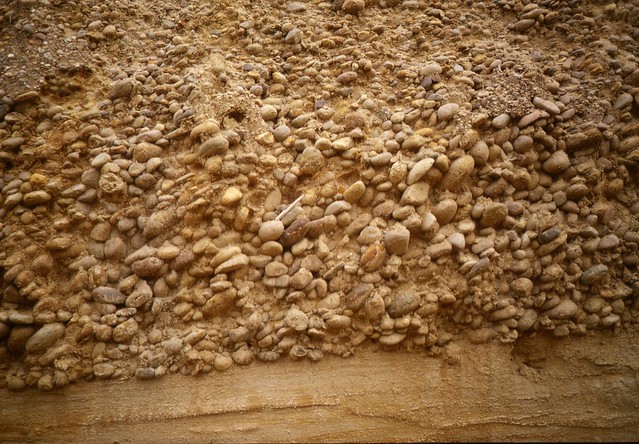
By now you’ve probably watched some of the chilling video footage of the devastating tsunami in Japan. The scale and power of water spilling over sea walls is on full display as cars are thrown about like twigs in a stream. I don’t know about you, but it makes me feel very small.
Images of the aftermath of the tsunami — after the waters have receded — don’t directly communicate the dynamic nature of theses processes, but they do show the product. The cars near the top of the photo above are a great example (for an even better view of the cars check out this photo on Boston.com’s Big Picture blog). These cars were parked in a lot ready for shipment when the rising waters pushed them together — stacking them in an overlapping pattern like shingles on a roof.
This pattern — called imbrication — is commonly seen in sedimentary deposits that are the product of moving water. Pebbles and cobbles will roll, bounce, and flip along the bottom of a river until they find a stable position resting up against the ‘back’ of another particle. Observing imbricated cobbles in ancient sedimentary deposits provides important information about the processes. For example, it can tell you the direction the flow was moving, which is valuable for reconstructing ancient environments. In the example below, the flow was from left to right, and in the photo of the cars, the flow was from right to left.
 Linking the product — what is left in the rock record — to the process that created the feature is fundamental to the science of geology. Disasters like this tsunami are (very scary) reminders of the power of moving water to reshape the Earth’s surface.
Linking the product — what is left in the rock record — to the process that created the feature is fundamental to the science of geology. Disasters like this tsunami are (very scary) reminders of the power of moving water to reshape the Earth’s surface.Images: 1) Aerial view on March 11 shows vehicles washed away by the earthquake-triggered tsunami in Hitachinaka, Ibaraki prefecture, Japan. The country’s biggest recorded earthquake slammed into its eastern coast that day. (Atsushi Taketazu/The Yomiuri Shimbun/AP). 2) Imbrication – Point Loma Formation (Jhonny E. Casas/Flickr)

Δεν υπάρχουν σχόλια:
Δημοσίευση σχολίου